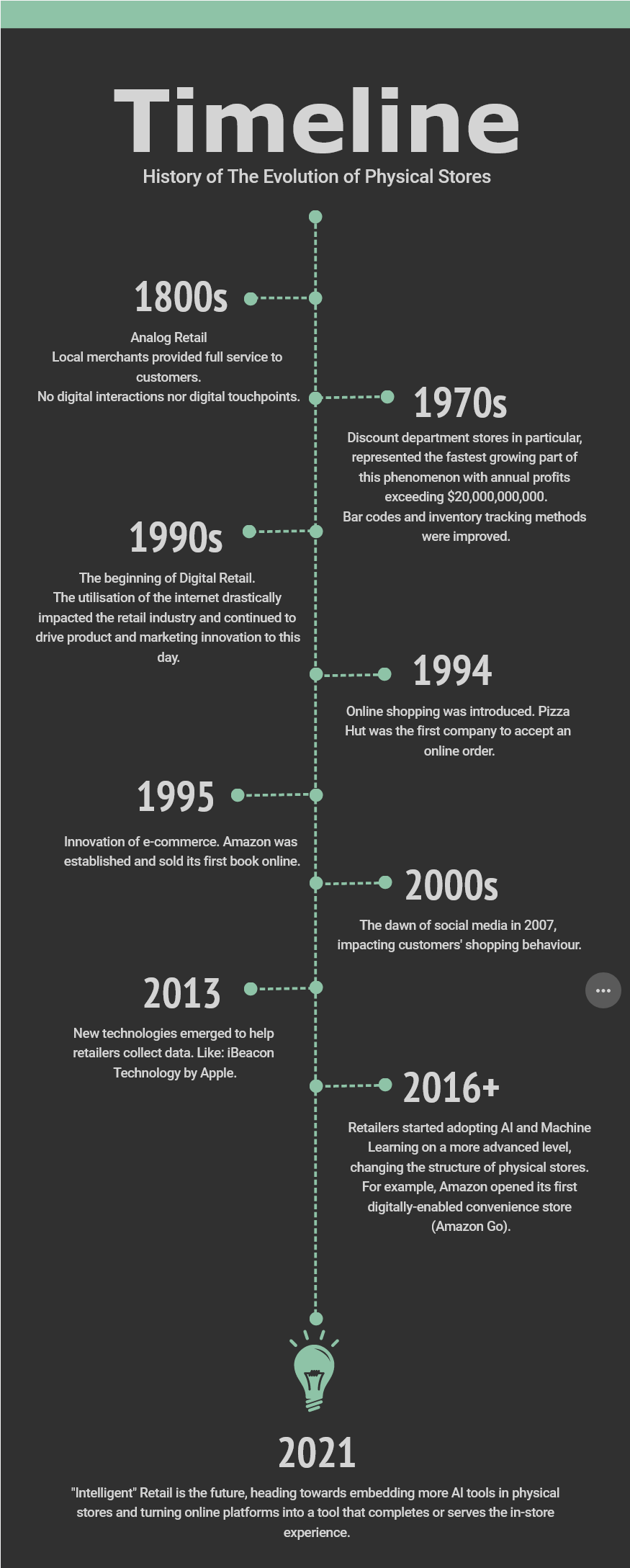

Modern retail has significantly changed throughout the years; moving away from the old traditional analog retail, where there were no digital interactions nor digital touchpoints, to the digital era that we are in today, where the internet has transformed how retailers and consumers view the intersections of product, place, price and time.
Today, shoppers have nearly unlimited access to a wide range of products, and their purchases are not restricted to a physical place or store hours. With a few clicks, shoppers can compare the prices of goods faster and more efficiently than before. Even in-store shopping is different now; there are digital interactive services like digital signage, mobile app... etc. to personalise the shopping experience, thus affecting consumers’ purchasing power and retailers’ revenue.
Recently, the focus has been directed towards the future, where stores seamlessly blend with their environment and harness data in their competitive advantage. Artificial Intelligence and Machine Learning are the keys to the success of retailers in the future.
Let’s observe how technology has changed the shopping experience between then and now.
1. Knowledge
Before: Customers came into stores with little to no knowledge and relied on a salesperson to advise them on what to buy.
Today: Shoppers do their own research to get the maximum value out of every dollar they spend. They compare prices, check reviews, and make decisions without leaving their homes.
2. CRM
Before: Retailing began with shopkeepers who would welcome in people and then try to know more about their customers' needs and preferences.
Today: Technologies enable retailers to go above and beyond to improve their offerings and promotions. This could be done through personalisation. In our constantly connected world, IoT and AI help retailers learn what matters to a consumer in a particular location and at a particular time.
3. Products have a real look and feel on the screen
Before: Shoppers used the internet to research products, but they were only restricted with certain options; they had to mainly make their decision based on photos and videos which were not enough.
Today: Interactive videos and shopping ads have introduced 360-degree imagery to some product sets to give shoppers a better sense of what an item really looks like. Some innovative retailers are even offering shoppers virtual try-on. And thanks to AI, digital screens in-store can boost this personalised customer experience, activating customer’s emotions, especially within the last 20 yards.
Forrester reports that by 2022 e-commerce sales will represent approximately 17% of total retail sales. As a result, retailers are improving their online presence and integrating traditional brick-and-mortar and e-commerce experiences for the consumer.
But how could these changes be applied? How can retailers succeed in this increasingly competitive environment?
Success comes from being a visionary. To be a true visionary, retailers and suppliers need to understand and plan for the changing forces influencing shoppers’ needs. A report published by IGD on the Consumer Goods Forum is examining the evolution of physical stores, discussing the ‘Four Forces of Change’ that might impact retailers, helping them to consider the issues shaping the future including urbanisation and aging populations, the increasing use of automation, the rise of anti-establishment feelings and the potential for a reversing of the process of globalisation.
Those four forces are:
Societal Shifts, Transformative Technology, Resource Resilience, Altering Authorities.

Despite e-commerce growth, shoppers, even in advanced markets, still choose in-store shopping instead of shopping online. Some shoppers suggest that the stores let them see, touch and feel products, and help them to take a quicker and more confident decision. Smart retailers, in collaboration with suppliers, can attract shoppers to stores by offering a unique experience through personalised promotions. They can also facilitate the overall experience through the usage of advanced technology, like cashier-less checkouts.
42% of shoppers are interested in promotional notifications when near a store.
44% are interested in being alerted to offers on their phone in different parts of the store.
44% are interested in collecting and using their loyalty card points through their phone.
‘Store of the future’ concepts are now launched around the world
The future is heading towards embedding AI in physical stores and turning online platforms into a tool that completes or serves the in-store experience.
Amazon Go
In 2016, Amazon opened its first digitally-enabled convenience store, called Amazon Go. The retailer claimed to have created the world’s most advanced in-store shopping technology, known as ‘Just Walk Out’ where, unlike most shops, there are no registers or cashiers. Shoppers’ accounts are automatically charged after their purchase. There are more advanced features; for example, the detection of products taken from or returned to shelves, like the minibar in some hotel rooms.
Two-thirds (63%) of UK shoppers say that a speedy experience at the checkout is very important to them as stated on ShopperVista from IGD.
A quick glimpse at the future of retail
When it comes to the future of retail, studies suggest that physical stores are going to be leading. What is going to change drastically is the way these physical stores operate and service their customers. Rapid advances in machine capabilities, combining both AI and robotics, promise to transform the economics of retailing and help improve the efficiency of and outlook for stores—although there might be short-term challenges to improve in-store services, embedding the latest technology, while reducing costs.
The trick is in finding the right balance between automation and human interaction; this is the key to winning customers’ loyalty and making stores more attractive. At intouch.com, we help retailers use the latest AI technology to improve their CRM. and drive more ROI. Get intouch!
